Q&A – Ask Neil: January 12, 2023
(Please read these instructions carefully.)
Before you post your question, please look at recent issues to see if someone else has already asked it. You might find your answer there.
How to submit your question…
• Click the link provided below to post your question. After you submit your question, a new window will pop up giving you the address to which you can e-mail a photo to accompany your question. Clear, medium-resolution photos. (Try to avoid low-res thumbnail photos, please, in case I have to zoom in to see things.)
• Click here to post your question.
• Please only post your question one time.
• One question per reader, please.
• Please use this only for posting questions – not for standard emails.
• Watch for your answer in the following week’s e-gardens.
• I choose those of greatest general interest. For example, plant IDs seldom make the cut.
• I must have your first name or initials.
• I must have your city or county. (Texas is a very large state.)
QUESTION 1
SHOULD I WORRY ABOUT MY ‘TWIST OF LIME’ ABELIAS?
Question: I have three Twist of Lime abelias that were planted last March. They were covered with frost cloth for six days during the cold spell three weeks ago. When the cloth came off each plant was dull green and now those leaves have turned brown. Should I be worried? Carol B., Waxahachie.
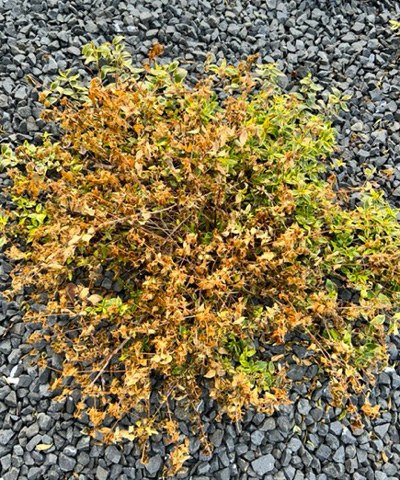
Answer: It’s still a bit early to know for sure. (See related story in last week’s e-gardens.) The twigs will be your best indicator. If they turn dry and brittle your plants will probably suffer some dieback. But don’t prune anything off for at least another month. By then it should become obvious if the plants were hurt or not hurt by the cold. As a side note, I’ve found the variegated abelias to be less durable to cold, sun and other extremes of Texas weather than the standard glossy abelia.
QUESTION 2
WHERE CAN I FIND HINCKLEY’S COLUMBINE?
Question: It is my understanding that Hinckley’s columbine, also known as Texas Gold columbine, is shade-tolerant and self-propagating, but I cannot find it anywhere. Any suggestions as to a source? Jett C., Denton.
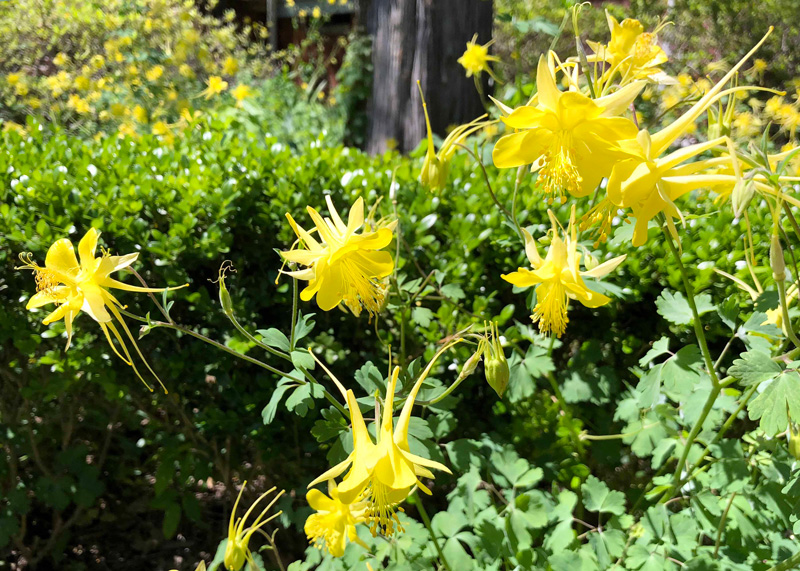
Answer: You won’t find it now. Nurseries don’t have their spring perennials out for sale yet. Most are still dormant. By March (into April in North and North Central Texas) most independent retail garden centers should be stocking it with their other perennials. You could begin to ask now if your favorite nursery will be handling it. It’s a stunning plant that I’ve grown for 25 years. Yes, it needs shade and highly organic, moist soil. Plant it in the same sort of setting you’d give ferns, violets, hostas and hellebores. Buy your transplants and set them 8 or 10 inches apart. Let them stay in place until their seeds mature and fall to the ground. You’ll see tiny seedlings start to germinate this fall, plus some of the parent plants will survive to bloom again next spring. (It’s a short-lived perennial that does self-sow to keep its population going.)
QUESTION 3
SHOULD VARIEGATED FLAX BE COVERED, ALSO CUT TO THE GROUND EACH SPRING?
Question: I planted variegated flax in fall 2020. I cover them each winter. They survive every year, but with browned leaves. Is it necessary that I cover them, and should they just be cut to the ground in February? Shawn S., Garden Ridge, Comal County.
Answer: Having heard a couple of my horticultural friends disparage it I haven’t tried it yet. But I need to because many others write and speak highly of it. It appears to be winter hardy only into the low 20s as judged by what I’ve seen online. I don’t remember how cold you folks got in February 2021 or December 2022, but it’s possible that it was cold enough to damage the foliage even with the plants covered. Yes, you’ll need to cover your plants anytime the temperature drops as low as what you faced three weeks ago. And you should trim to remove all the browned foliage. More leaves will be produced to replace it.
QUESTION 4
WHAT WOULD CAUSE LEAVES OF FOXGLOVES TO DISAPPEAR?
Question: I planted two foxgloves next to some small existing plants shortly before the freeze three weeks ago. In the last week something has been removing all the leaves from the new plants. One is completely gone. I’ve had foxgloves for three years and have no idea what is doing this. Ginger L., Fort Worth.
Answer: Nor do I, but if it were an animal, including any kind of insect or pillbugs, etc., I would expect it to have been harvesting leaves from the small plants as well. My guess would be that the new plants were not acclimated to cold conditions as they came to your gardens and that the extreme weather took its toll on them. Normally foxgloves will stand up to the cold, but if not hardened properly, any plant could have been damaged. That’s my best guess without seeing the plants during the process.
QUESTION 5
WHY IS MY LIGUSTRUM DROPPING LEAVES?
Question: My ligustrum suddenly started dropping leaves this week. I had problems with my sprinkler system. I hope a lack of water isn’t the issue. James T., Arlington.
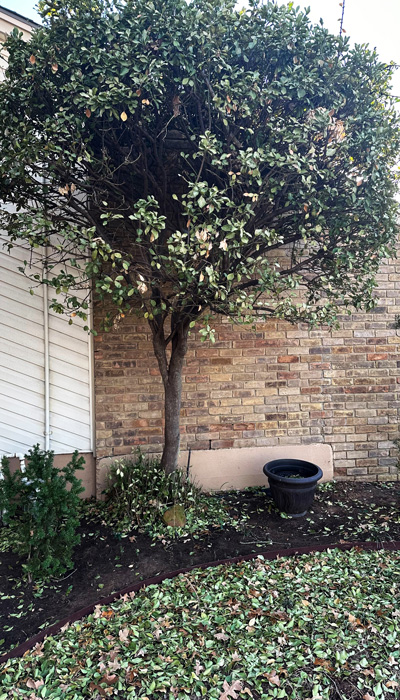
Answer: I’ve lived in the Metroplex for 52 years and I’ve seen several cold-winter cycles that have either knocked all the leaves off waxleaf ligustrum or killed them entirely. I think that’s what’s happening to your plant. Freeze damage to waxleafs looks like someone walked on the leaves with hot golf cleats. (I can’t make out any details in the photo. I brightened it a good bit and still can’t see things very well.)
QUESTION 6
ARE HELLEBORES INVASIVE?
Question: We bought hellebores for the first time this winter – named varieties from a well-known and highly respected Dallas nursery. We planted them in shady areas around our yard. Now we’re reading online that they are very invasive, nearly noxious weeds. What are your thoughts? Liz R., Hurst.
Answer: Oh, good grief. You will be fine. Hurst is safe. The Metroplex isn’t going to be overrun. Forgive me for what I’m about to write, but the people who cry wolf about invasive plants just about wear me out. They’re often lacking facts or are writing about some entirely different part of the world. We definitely do have many invasive species here in Texas (Amur River privet, Japanese ligustrum, Chinese tallow, etc.), and I respect and repeat those warnings. But Hellebores? Where did people come up with that? Not in DFW. You’ve bought a lovely batch of perennials that will bring beauty to your landscape. The nursery you mentioned would never sell you anything that would cause you a problem.
QUESTION 7
WOULD THE COLD THREE WEEKS AGO HAVE KILLED OFF TAKE ALL ROOT ROT?
Question: We have St. Augustine with Take All Root Rot. I did use peat moss on it but no other treatment. I’m hoping the deep freeze three weeks ago would have killed the disease. What are your thoughts? Sharon B., Cedar Hill, Dallas County.
Answer: The cold would not have impacted the TARR fungus. On the bright side, however, there is a much less expensive, more effective and easier treatment than applying the peat moss. Save your peat moss for use as a soil amendment in the garden. In the past four years the fungicide Azoxystrobin has come into the consumer market with label clearance for TARR, gray leaf spot and brown patch in St. Augustine turf. It is sold in the Scotts product line as Scotts Disease-EX.
QUESTION 8
ARE VIBURNUMS DISEASE-PRONE? THEY ALSO HAD HORDES OF SMALL, WHITE FLYING INSECTS.
Question: My son’s new large viburnums all had hordes of small, white flying insects on them this past summer. I think they were aphids. I sprayed them twice, but there are still small specks on the leaves. Are they disease-prone? The freeze also really got them. Randy R., Tyler.
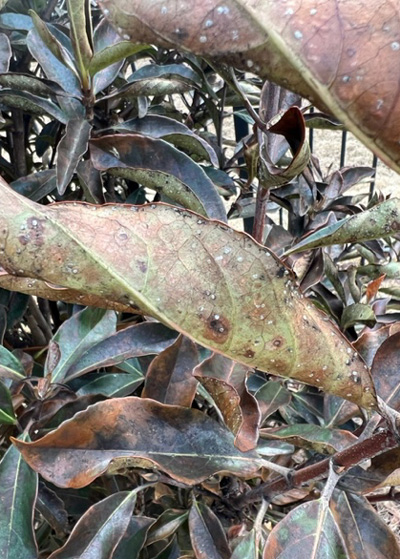
Answer: Aphids don’t typically fly. They are always pear-shaped. I’ve been around viburnums of several types all of my life and I honestly don’t recall seeing any insects or diseases on them. However, sweet viburnum (this one) is winter-tender when temperatures drop into the teens. It is a beautiful species, but I believe the cold is the total cause of your son’s plants’ problems. (I guess letting them get too dry during the drought last summer also could have been a factor if they were struggling back then, but this looks much more like cold injury.)
QUESTION 9
IS IT TOO EARLY TO APPLY PRE-EMERGENT GIVEN THE UNUSUALLY WARM WEATHER?
Question: Is it too early to apply pre-emergent weedkiller given the unusually warm weather? I usually apply it around mid- to late February. This year it seems like there may not be another frost. Katherine S., Cedar Park.
Answer: It’s still the first half of January! I don’t know any weather people who are willing to make the same assumption you are. You still have probably a 95 percent chance of another killing frost. You need to wait on the pre-emergent. (You wouldn’t hurt anything by applying it now, but you’d have to make a third application after 90 plus another 90 days to get yourself through the entire weed-germinating season. My recommendation is that you wait until the normal time for your area.)
QUESTION 10
WHY DO OUR LOROPETALUMS KEEP DYING?
Question: We have purchased many loropetalums – Chinese fringeflower plants. Some are doing well and some are dying. We have replaced the same dead ones twice. What are we doing wrong? The front of the house faces northeast and the side of the house faces north. Sara A., McKinney.
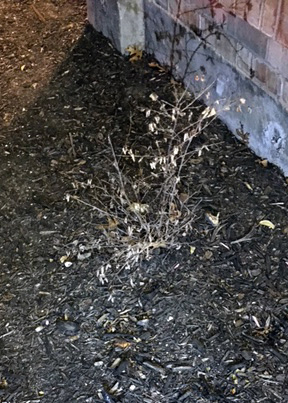
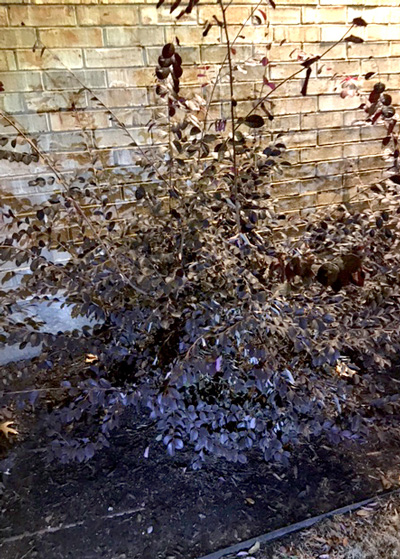
Answer: My wife and I live in McKinney also, and I, too, tried loropetalums for a while. That was 15 or 20 years ago, but I’ve added them to my “never again, Neil” list of plants for this area. (Think about how few you see that are more than 3-4 years old.) They require acidic soils (Collin County soils are highly alkaline) and acidic irrigation water (our tap water out of Lake Lavon is even more alkaline – Yikes!). You can plant them into the same kind of specially prepared acidic mix that you’d give azaleas and they’ll last a few more years, but they would eventually just play out. You also need to check your sprinkler system if you have one to be sure the heads are functioning properly and that the plants in the “dead zone” are getting enough water. The cold three weeks ago also burned loropetalum foliage badly around town.
